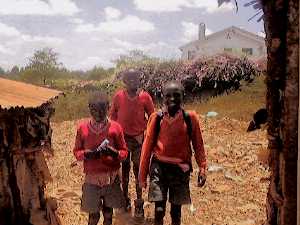The history of Mji wa Huruma villageMji wa Huruma is one of the poorest slums in Nairobi. It is situated in the thick of Karura Forest and borders Runda estate. Its main access is through Nairobi-Kiambu road or Nairobi-Limuru road. The village measures approximately 500 square meters and is home to about 1500 inhabitants. The plot on which the village stands belongs to the government. The name Mji wa Huruma means home of mercy. This is because the village neighbours a home for the aged people which is run and managed by the Salvation Army church. The home though was originally meant to be a rehabilitation center for street children. The people living at Mji wa Huruma originally came from the present Runda; then called Cheleta. Cheleta was the European who owned the entire Runda estate which was then occupied by coffee plantations. This dates back to colonial days. Most of the people living there and their great-grand-parents worked there as casual labourers and where housed within the plantations. Late in 1978 the people living at Cheleta were facing imminent eviction. This was as a result of change of ownership of the farms from the colonialists to indigenous Kenyans. As the land changed hands in terms of ownership the plight of the people living and working there was ignored. The people who were facing eviction decided to file the case in court, trying to stop the eviction. The case was however not given fair hearing and was hurriedly decided in favour of the owners of the farm. It was decided that those people be given an alternative site to settle. A site was found, but unfortunately illegally grabbed by those handling the case in court. One of them was an advocate and the area counselor. Finally the people settled at the current site which is a government plot. The village has been there since 1979. The new owners subdivided the land into plots and sold these to individuals who built private living quarters. Runda is now one of the most posh living areas.
When the schoolchildren come home to their simple huts, Life before colonialismJust like all other African countries, before colonization, Kenyans had their own ways of living. Kenia is made up of more than 40 tribes, each speaking their own language an with their own unique ways of living. The Kikuyu, which happens to be the predominant tribe at Mji wa Huruma, is also the biggest in Kenya. They occupied and still do occupy much of Central province and parts of Rift Valley province. The Kikuyu are Bantus an are believed to have migrated from Zaire through Uganda an Tanzania. The Kikuyu just like all other tribes had their own way of life. They worshipped their god whom they called 'Ngai'. They believed he resided at Mt. Kenya (Kirinyaga) and therefore faced the direction of the mountain as they prayed. They also had ceremonies and rituals that were celebrated at different occasions. Land ownership and tenure war per clan (Mbari). Each clan had several families that settled together and had a council of elders which governed all matteres of that particular clan. Therefore it is quite clear that there was no individual ownership of land. As the colonialists came into Kenya, they did away with our set of laws and instead introduced their draconian laws. They established standard administrative organs, viz the Chief, the Divisional Officers (D.O.), the District Commissioner (D.C.), the Provincial Commissioner (P.C.). The idea was to ensure strict adherence to the laws. The administrative officers had excessive powers and were used to suppress Africans. They were also used as overseers in the settlers plantations, were Africans were subjected to forced labour. The colonialists were very much concentrated in the most fertile lands of Kenya. These were mainly the central province and parts of the Rift Valley. They were popularly known as the Whites Highlands. Africans were forced out of these areas and concentrated in the most unfertile lands called the Natives Reserves. After being stripped of their main economic activities (farming), Africans had no alternative but to be employed by the colonialists in their vast plantations mainly under coffee, tea, pyrethrum and cotton. On top of that they were subjected to heavy taxes mainly brutally collected. Those in arrears were severely punished. The struggle for freedomThe Africans were very bitter and decided to fight for what was rightly theirs. There were armed struggles against the whites from all over Kenya. The most distinct and organized was among the Kikuyus. Most Africans though could not match the sophisticated weapons used by the Europeans. Africans had home made guns and were mainly concentrated in forests. The Mau Mau under the leadership of Kenya's first president was the armed organ of Kenya's (mainly Kikuyu) struggle against cononialism until the late 1950's. After years of fighting the colonialists realised there were heavy casualties on both sides and opted for dialogue. There were a series of negotiations both in Kenya and Britain. Between 1960 and 1962 several constitutional conferences were held to negotiate Kenyas independence constitution. In 1963 Kenya was granted her independence. Jomo Kenyatta was then Prime Minister and became Kenyas first President in 1964. |
